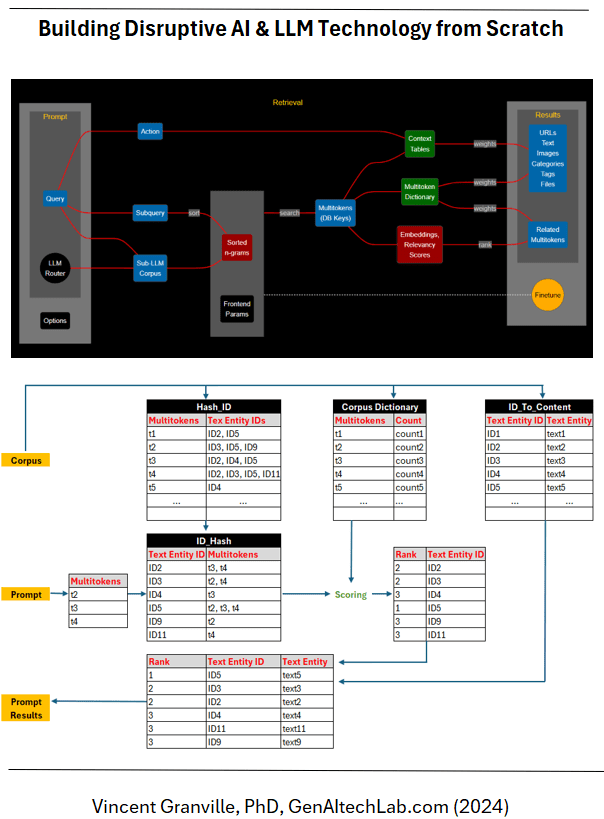This book features new advances in game-changing AI and LLM technologies built by GenAItechLab.com. Written in simple English, it is best suited for engineers, developers, data scientists, analysts, consultants and anyone with an analytic background interested in starting a career in AI. The emphasis is on scalable enterprise solutions, easy to implement, yet outperforming vendors both in term of speed and quality, by several orders of magnitude.
Each topic comes with GitHub links, full Python code, datasets, illustrations, and real-life case studies, including from Fortune 100 company. Some of the material is presented as enterprise projects with solution, to help you build robust applications and boost your career. You don’t need expensive GPU and cloud bandwidth to implement them: a standard laptop works.

Part I: Hallucination-Free LLM with Real-Time Fine-Tuning
Focuses on high performance in-memory agentic multi-LLMs for professional users and enterprise, with real-time fine-tuning, self-tuning, no weight, no training, no latency, no hallucinations, no GPU. Made from scratch, leading to replicable results, leveraging explainable AI, adopted by Fortune 100. With a focus on delivering concise, exhaustive, relevant, and in-depth search results, references, and links. See also the section on 31 features to substantially boost RAG/LLM performance.
Part II: Outperforming Neural Nets and Classic AI
Discusses related large-scale systems also benefiting from a lightweight but more efficient architecture. It features LLMs for clustering, classification, and taxonomy creation, leveraging the knowledge graphs embedded in and retrieved from the input corpus when crawling. Then, in chapters 7 and 8, I focus on tabular data synthetization, presenting techniques such as NoGAN, that significantly outperform neural networks, along with the best evaluation metric. The methodology in chapter 9 applies to most AI problems. It offers a generic tool to improve any existing architecture relying on gradient descent, such as deep neural networks.
Part III: Innovations in Statistical AI
Features a collection of methods that you can integrate in any AI system to boost performance. Based on a modern approach to statistical AI, they cover probabilistic vector search, sampling outside the observation range, strong random number generators, math-free gradient descent, beating the slow statistical convergence of parameter estimates dictated by the Central Limit Theorem, exact geospatial interpolation for non-smooth systems, and more. Efficient chunking and indexing for LLMs is the topic of chapter 10. Finally, chapter 15 shows how to optimize trading strategies to consistently outperform the stock market.
See contents and get your copy
Published in October 2024 by GenAItechLab.com, 193 pages. Includes glossary, index, bibliography, dozens of illustrations and tables, and various clickable references both internal and external. Easy to browse in Chrome, Edge or any PDF viewer. Get your copy, here. See table of contents, here.
Author

Vincent Granville is a pioneering GenAI scientist and machine learning expert, co-founder of Data Science Central (acquired by a publicly traded company in 2020), Chief AI Scientist at MLTechniques.com and GenAItechLab.com, former VC-funded executive, author (Elsevier) and patent owner — one related to LLM. Vincent’s past corporate experience includes Visa, Wells Fargo, eBay, NBC, Microsoft, and CNET. Follow Vincent on LinkedIn.
